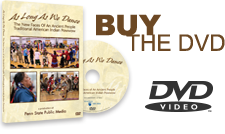Penn State Public Media - As Long As We Dance: The New Faces of an Ancient People Traditional American Indian Powwow
 mediasales.psu.edu
mediasales.psu.edu
Press Inquiries
Matt Caracappa
mnc5000@psu.edu
Program Information
Cheraine Stanford Producer/Director
cps13@psu.edu
814-867-1390

Songs & Dances
Men’s Traditional Dance. This is one of the oldest dances, and has many different patterns and styles, which represent the man’s native family and individuality. Often, items of the Traditional Dancer’s clothing or items he dances with have great significance or are heirlooms passed down through the generations. Traditional dancers may wear a circular bustle of Eagle feathers, representing the circle of life.
Men’s Grass Dance. A traditional dance that was done for many years on the
prairies, the Grass Dance was done to make a circle before the Creator and clear the way for the other dancers. Grass Dancers originally wore outfits made from grass. They would begin to dance, making a circle in the tall grass by gracefully pressing the grass down. Their movements resembled the swaying of the prairie grasses. Today, many Grass Dance outfits are made from yarn and ribbons and many dancers carry a braid of sweetgrass.
Men’s Fancy Dance. The flashiest and most athletic of Men’s dances, the Men’s
Fancy Dance is a modern interpretation of the older Traditional and Grass Dances. This dance style is characterized by bright, colorful beadwork, brilliant hued double feather bustles and knee bells for keeping time. Dancers use intricate, rapid footwork and quick spins.
Women’s Traditional Dance. This dance is in honor of the woman’s role as giver of life and keeper of the home, family, and culture. Women’s traditional dance styles reflect women’s close connection to Mother Earth by never allowing their feet to completely leave the ground. Northern traditional dancers usually dance in one place; Southern traditional dancers usually dance clockwise around the dance arena.
Women’s Jingle Dress Dance. Originating from the Ojibwe people of the
Great Lakes area, this dance spread rapidly through the Northern Plains. The dance is said to have originated as a healing dance that was given in a dream to the parents of a young lady who was sick and subsequently recovered after performing the dance as prescribed. The jingles on the dresses are made from tobacco can lids, and make a pleasing sound as the dancer moves. Tobacco is sacred, and the jingle dance asks for good health for the people. It is said that there is good medicine when a jingle dancer is present.
Women’s Fancy Shawl Dance. This modern style dance features elaborate footwork and athletic movement similar to that of the Men’s Fancy Dance, but with more movement, especially spinning. The women wear decorated fringed shawls and brightly colored matching beadwork. This dance is sometimes called the Butterfly Dance because the women open and close their shawls like butterfly wings.
Intertribal Songs. Intertribal songs can be very old or very contemporary. During
Intertribal Dances, all dancers, including visitors, may dance. Intertribals allow all nations, styles, ages and genders to dance, and are the most common songs at a traditional intertribal powwow such as the New Faces of an Ancient People Traditional American Indian Powwow.
Honor Songs. Usually sung in honor of a particular person, honor songs are also sung for groups or sacred items. When an honor song is sung, it is respectful to stand and remove your hat.
Round Dance. The Round Dance is a social dance in which all dancers and visitors can participate. Dancers move clockwise in a circle around the drum, in a step-up fashion, with faster moving lines in the center, and slower moving lines on the outside. The Round Dance represents unity.
Two-Step. The Two-Step is a social dance with male and female dancers dancing as partners. Visitors may also be invited to join. Led by the head dancers, couples follow. This is the only dance in which men and women dance together as partners.
Crow-Hop. The Crow-Hop is danced by both men and women and is said to have originated in the Crow Nation. This dance has a very distinctive musical beat and is unlike any of the other songs.
Smoke Dance. The Smoke Dance is a longhouse dance of the Haudenosaunee people, which has become very popular as an exhibition dance at powwows because of its intricate footwork and intense speed. Both men and women dance the contemporary exhibition Smoke Dance.
Hoop Dance. The Hoop Dance is an exhibition dance performed by a single dancer with a stack of up to 30 hoops. As the dancer dances, he uses the hoops to create the images of various shapes, animals, and stories in time with the drum.
Snake Dance. One of the oldest dances, the Snake Dance imitates the journey of a snake. Led by the Head Man Dancer, the dancers follow each other in a single line, winding in and out in a snake-like manner.
Blanket Dance. Named for purpose rather than a specific dance style, a Blanket
Dance is an opportunity for those present to make a donation as a blanket or shawl is carried around the perimeter of the dance arena. The purpose is announced prior to the singing of the song for this dance, and visitors may contribute voluntarily and in whatever amount they deem appropriate.